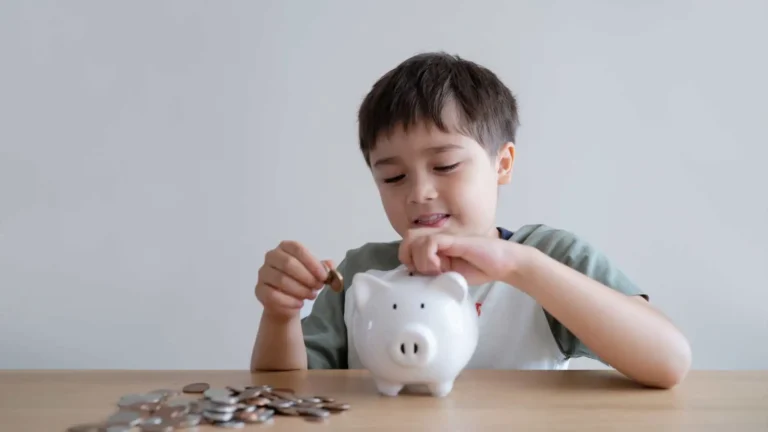Table of Contents
Introduction
The way we think about money starts quite early in our lives. These habits often stick for life. That’s why teaching young kids about money is so important. Teach kids about saving and budgeting, even with simple lessons, to help shape their approach to saving and spending. These lessons guide us in making smarter financial decisions as adults.
Being open about money is essential. You don’t need to have all the answers as a parent. This will involve your child in everyday conversations. It can help build their confidence over time. The challenge is determining when to begin and how much to teach. This is because every child is different.
The good news? You don’t have to do it all at once. You can lay the foundation for a lifetime of smart money habits. This can be achieved with age-appropriate lessons and a little patience.
Beem makes saving simple and rewarding with tools that help you plan and track your financial goals. Earn up to 5% APY — that’s 11x the national average. Grow your savings faster in a secure, FDIC-insured account.
Why Starting Early Matters
Kids pick up more than we think. It is especially when it comes to money. Starting early with simple ideas helps them build important life skills. It can be like saving or waiting for something they want. This helps them in making small choices at first. Then they can develop patience, decision-making skills, and self-control.
Kids are more likely to grow up confused about how money works. When we delay teaching money basics, we fall into bad habits later. Early guidance can make a significant difference in the long run.
Understanding Children’s Financial Learning Stages
Children learn about money in a step-by-step manner. This makes sense to a preschooler, but it won’t work for a teenager. Here’s how to meet them where they are. They understand concepts that grow as they do through lessons.
Ages 3–5: The Awareness Stage
At this age, kids start noticing money. They must understand that it’s used to buy things.
- Keep it light. You can pretend to play with toy cash registers or simple counting games.
- Show that money is a tool. This is not something to stress about.
Ages 6–9: The Habit-Building Stage
This is an ideal time to introduce the basics of saving and managing your finances.
- You can use jars or piggy banks. It can be labeled “Spend,” “Save,” and “Share.”
- You can discuss the distinction between wants and needs. This is helpful in everyday situations.
Ages 10–13: The Budgeting Foundation Stage
Kids are ready to plan and set short-term goals.
- Help them budget their allowance or earned money.
- Introduce simple tools. It is similar to notebooks or kid-friendly apps for tracking spending.
- You must encourage saving for something meaningful. It can be such as a toy, game, or special event.
Ages 14–18: The Independence Stage
Teens can start managing real money. This helps them prepare for financial independence.
- You can open a student bank account or prepaid debit card with them.
- One can talk about budgeting and digital payments. It helps them save for major goals, such as college.
- Discuss real-world concepts. It can be like credit, debt, and long-term planning.
Also Read: Back-to-School Savings: Timing, Swaps, and How to Buy Used
How to Introduce Saving Naturally
Saving doesn’t have to feel like a rule. But it can be something kids enjoy and feel proud of.
Start with a simple, hands-on tool. It can be like clear jars or kid-friendly savings apps. This allows them to see their money grow. You must celebrate small milestones. This will make saving feel rewarding. It can be like reaching their first $5 goal.
Instead of saying, “You can’t spend that,” try helping them set a fun goal to save for. When saving has a purpose, it makes more sense. This helps habits stick better.
Teaching Budgeting in Simple Terms
Budgeting doesn’t have to be complicated. It is especially for kids. A great place to start is by dividing money into three basic categories. It is save, spend, and give. This helps them see that money has different purposes.
As they grow, you can gradually introduce more structure. It is similar to planning how to use a weekly allowance or tracking birthday money. Even talking through a small online purchase together can teach them how to make thoughtful choices.
The goal isn’t perfect math. However, it’s about building awareness and confidence in everyday money decisions.
The Role of Allowance in Financial Education
Allowance can be one of the most effective tools. This is designed to teach children how to manage their finances. When given consistently, it helps them learn to plan, save, and make choices. It is just like adults do with a paycheck.
There’s often debate around whether allowance should be tied to chores. Some parents believe kids should earn their money. This is while others prefer to give a set amount to teach budgeting separately from household responsibilities. There’s no one-size-fits-all answer. But it depends on your family’s values.
Allowance provides kids with real-world practice. This is regardless of your approach. It helps them learn to prioritize, make trade-offs, and take responsibility for their spending. This is all in a safe and low-pressure environment.
Teaching the Value of Delayed Gratification
A child must learn to value what they have. It is one of the most important money lessons. You don’t always get what you want right now. And that is completely okay.
You can also help kids save up for something they really want. It can be like a game or a special outing. This will teach them patience and the importance of planning. It’s not just about the money. But it’s about building self-control. Kids must learn to think ahead.
When kids experience the reward of reaching a goal after waiting, they feel a sense of pride. That feeling sticks with them. This helps build the kind of financial maturity that lasts into adulthood.
Making Money Lessons Age-Appropriate and Fun
Money lessons don’t have to be serious or boring. This is true especially for kids. Using stories, games, or little challenges turns learning into play. You must learn to budget; fun keeps them engaged. This is whether it’s a pretend store, a savings race, or a story about a character.
Reward systems can also help. It is like matching a portion of their savings to encourage consistency. It’s a simple way to show that saving pays off.
Involving Kids in Family Financial Conversations
You don’t need to discuss mortgage rates or bills with your kids. But letting them in on smaller money decisions can go a long way.
You must involve them in the planning of a family trip. They can also help you choose groceries on a budget. Sometimes ask them to decide whether to eat out or cook at home. These everyday moments help kids understand financial situations. They can learn that money is more than just spending. But it’s about making choices.
Common Mistakes Parents Should Avoid
- Waiting too long before one starts the conversation.
- Money lessons don’t need to be complicated. It can start early with simple ideas and build confidence over time.
- Making it too complex or stressful.
- Avoid heavy terms or sharing adult money stress. You can keep it clear, calm, and age-appropriate.
- Missing everyday teaching moments.
- Kids learn best in real-life situations. It can be at the store or while planning a trip. You must save for something they want. Don’t miss those natural opportunities to talk and teach.
Building Lifelong Financial Habits
Good money habits don’t happen overnight. But they’re built through small, consistent lessons over time.
Start with simple daily routines. This is such as saving a little from your allowance or discussing spending choices. As your child grows, they gradually take on more responsibility. It is similar to managing one’s own lunch money. It can also be related to budgeting for outings or using a student account.
The goal is to prepare them for real independence. This way, by the time they leave home, they will feel confident making smart financial decisions on their own.
Also Read: How to Raise Financially Responsible Kids Without Overwhelming Them
Conclusion
There’s no “perfect” age to start teaching kids about money. Every child learns this at their own pace. What matters most is starting early and staying consistent. You need to maintain a positive attitude about this.
You’re not just teaching them about dollars and cents with gentle guidance and everyday lessons. But you’re helping them grow into confident, thoughtful money managers.
Ultimately, the goal isn’t just to raise kids who know how to budget. But it’s raising kids who understand that money is a tool. It is a medium for stability, freedom, and generosity.
Save more efficiently with Beem app, offering high-yield accounts that beat standard bank rates. Earn up to 5%
APY on your Savings Account. Set automatic savings and reach your financial goals faster.
FAQs on the Best Age to Teach Kids About Saving and Budgeting
What’s the best age to start teaching my child about money?
Start introducing money concepts as early as age 3 or 5. This can be through play and daily conversations. Keep lessons simple and visual.
How do I teach saving to a child who wants everything immediately?
You must set small goals and reward patience. Use visual progress trackers to show growth and celebrate milestones.
Should I open a bank account for my child?
Yes—by age 10–12, supervised savings accounts can help kids. They can understand digital banking and responsibility.
How much allowance should I give for teaching budgeting?
It depends on age and family income. The key is consistency and linking money to accountability or effort.
What’s the most important financial habit to teach first?
Saving before spending. Instilling this mindset early creates a foundation for smart financial behavior later.
















































